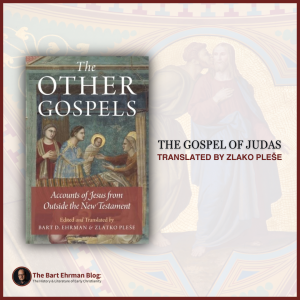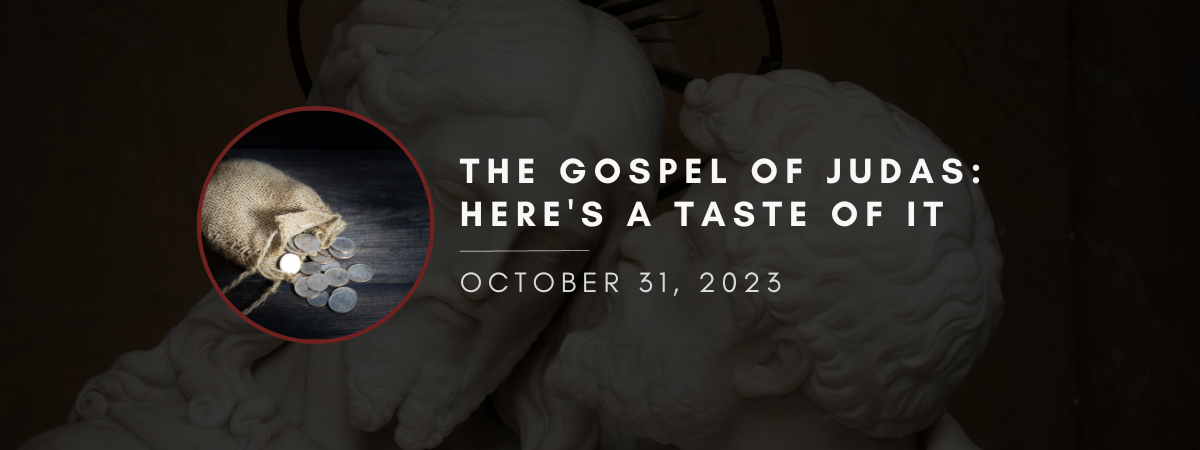Here is the first bit of the Gospel of Judas from the translation of my colleague Zlatko Pleše in our book The Other Gospels.
The first paragraph is the explanation of where we got the text from; then the translation of the opening scene. After this bit here, the Gospel gets very strange, at least to most modern readers. But as you can see, it is really interesting.
At the end I give the bibliography for further reading that we cite in our book.
This translation is based on the Coptic text of Rodolphe Kasser, and Gregor Wurst, eds. The Gospel of Judas: Critical Edition. Washington, DC: National Geographic, 2007. New portions of the Gospel appeared in 2006, when the one-time owner of the manuscript declared bankruptcy and his remaining antiquities collection was turned over to a bank in Ohio; included in this collection were numerous small fragments of the Gospel of Judas. These have been photographed and they have begun to be studied; for our translation of the account here we have been able to take them into consideration (see the “Preliminary Report” by Krosney, Meyer, and Wurst in the bibliography).
(An elipsis […] indicates a place where the manuscript [and therefore the words it contains] is missing.)
The Gospel of Judas
Translated by Zlako Pleše
33 The secret discourse of revelation that Jesus spoke with Judas Iscariot in the course of eight days, three days before he celebrated Passover.
Gospel Frame: Jesus’ Ministry
When he appeared on earth, he performed signs and great miracles for the salvation of humankind. And since some walked on the path of righteousness and others walked in their transgression, the twelve disciples were called. He began to speak with them about the mysteries that are beyond the world and what will happen at the end. Oftentimes he would not disclose himself to his disciples, but when necessary,[1] you would find him in their midst.
First Day: Jesus Separates Judas from Other Disciples
One day he came in Judea to his disciples, and he found them seated and gathered together, practicing godliness.[2] When he approached his disciples 34 as they were assembled together, seated and giving thanks over the bread, he laughed. But the disciples said to him, “Teacher, why are you laughing at our thanksgiving? What have we done? This is what is appropriate.” He replied and said to them, “I am not laughing at you. You are not doing this out of your own will: rather, your god will receive praise through this.” They said, “Teacher, you . . . are the son of God.” Jesus said to them, “How do you know me? Truly I say to you that no generation will know me from the people that are among you.”
Now when his disciples heard this, they began to feel irritated and angry, and to blaspheme against him in their hearts. And Jesus, when he saw their senselessness, said to them, “Why has this agitation produced wrath? Your god who is within you and his powers[3] 35 have become irritated with your souls. Let the one who is strong among you people bring forth the perfect human being and stand before my face!”
And they all said, “We are strong.” Yet their spirit could not dare to stand before him, except Judas Iscariot. He was able to stand before him, yet he could not look him in his eyes, but rather turned his face away. Judas said to him, “I know who you are and where you have come from. You have come from the immortal aeon of Barbelo and from the one that has sent you, whose name I am not worthy to utter.”
But Jesus, knowing that he was thinking of something lofty, said to him, “Separate from them, and I will tell you the mysteries of the kingdom, not so that you may go there, but that you may grieve greatly. 36 For someone else will take your place, so that the twelve disciples may again be complete with their god.”[4] And Judas said to him, “When will you tell me these things, and when will the great day of light dawn for that generation?” But when he said these things, Jesus left him.
Second Day: Jesus Appears to His Disciples Again
The next morning he appeared to his disciples, and they said to him, “Teacher, where did you go and what were you doing after you left us?” Jesus said to them, “I went to another generation, one that is great and holy.” His disciples said to him, “Lord, what is the great generation that is superior to us and holy, but is not in these aeons?”
When Jesus heard this, he laughed. He said to them, “Why are you pondering in your heart about the strong and holy generation? 37 Truly I say to you, no one born of this aeon will see that generation, nor will any angelic host of the stars rule over that generation; and no person of mortal birth will be able to join it. For that generation is not from . . . that has come to be . . . the generation of humans . . . but it is from the generation of the great people . . . the powerful authorities . . . nor any power . . . those in which you rule.”
When his disciples heard this, they each became disturbed in their spirit, and they did not find anything to say.
******************************
Bibliography
Brankaer, Johanna and Bethge, Hans-Gebhard. Codex Tchacos: Texte und Analysen. TU 161. Berlin-New York: Walter de Gruyter, 2007, pp. 255-372.
Ehrman, Bart D. The Lost Gospel of Judas Iscariot: A new Look at Betrayer and Betrayed. New York: Oxford University Press, 2007.
Kasser, Rodolphe, Marvin Meyer, and Gregor Wurst, The Gospel of Judas. Washington, D.C.: National Geographic, 2006. (Contains an English translation and interpretive essays by Kasser, Meyer, Wurst, and Bart Ehrman); the second edition, 2008, contains additional essays by Craig Evans and Gesine Schenke Robinson.
Kasser, Rodolphe and Wurst, Gregor. The Gospel of Judas, Together with the Letter of Peter to Philip, James, and a Book of Allogenes from Codex Tchacos: Critical Edition. Introductions, Translations, and Notes by R. Kasser, G. Wurst, Marvin Meyer, and François Gaudard. Washington, D.C.: National Geographic, 2007.
Krosney, Herb. The Lost Gospel: The Quest for the Gospel of Judas. Washington, D.C.: National Geographic, 2006.
Krosney, Herb, Marvin Meyer and Gregor Wurst, “Preliminary Report on New Fragments of Codex Tchacos,” in Early Christianity 1 (2010) 282-94.
Plese, Zlatko. “Gnostic Literature,” in Religiöse Philosophie und philosophische Religion der frühen Kaiserzeit Literaturgeschichtliche Perspektiven. Ratio Religionis Studien I, ed. Rainer Hirsch-Luipold, Herwig Görgemanns, Michael von Albrecht, and Mitarb. v. Tobias Thum. Tübingen: Mohr Siebeck, 2008; pp. 163-98, esp. 173-74.
Schenke Robinson, Gesine, “Judas, a Hero or a Villain?” in Kasser, Meyer, and Wurst, The Gospel of Judas, pp. 155-68.
Scopello, Madeleine, ed. The Gospel of Judas in Context. Proceedings of the First International Conference on the Gospel of Judas. Paris, Sorbonne, October 27th-28th, 2006. NHMS 62. Leiden: Brill, 2008.
Wurst, Gregor. “Gospel of Judas, New Fragment III.” Paper presented at the Ninth International Congress of Coptic studies, IACS, Cairo, September 2008.
[1] Or, perhaps, “you would find him as an apparition,” or “as a child.”
[2] See 1 Tim 4:7; or: “disputing issues concerning God.”
[3] Or: “stars.”
[4] See Acts 1:15-26; John 17:13, 23; some scholars propose “elements” or “stars” instead of “disciples.”
You must be logged in to post a comment.Share Bart’s Post on These Platforms
10 Comments
Leave A Comment









Whoa! Let’s unpack this laugh for a minute. Now that’s a new one! Jesus’ laughter here is a real eye-opener. It seems to go beyond mere humor or irony; it’s more of a knowing chuckle. Could it he’s aware of something far deeper than what the disciples are realizing?
He laughs four times in this Gospel! And no, it’s not a knowing chuckle. He’s laughing *at* the disciples because they think the God of this world who created material sustenance for material bodies is the true God who deserves to be worshiped.
Very interesting. Thanks for the read!
What do the bold “verse” numbers mean (33-37) and where do they come from? Are they in the original text?
They are page numbers in the manuscript.
Isn’t the Gospel of John leaning toward gnosticism? A divine being coming to our realm to lead us back to heaven . . . sounds gnostic. Could John at least have been a key in the mix with neo-Platonism that gave rise to gnostic ideas?
Or, was John influenced by gnosticism, but made it more “orthodox”? Would that show that gnostic ideas began pretty early on?
I’ve heard it described as proto-Gnostic: it was written around 130 CE give or take, a bit before the Gnostic movement seems to have emerged. Still, it does contain many elements that would later be integral to most Gnostic schools: preexistence, being God but still an individual entity (much like an aeon), the name Logos, and a strong indication that he did not have an actual physical form (such as his ability to appear in distant places at the same time and hide his identity when it suited him.)
Do we have proto-orthodox reactions to this story?
Just Irenaeus. He blasted it as a false Gospel propagated by a nefarious group of the Gnostics called the CAinites, who held all sorts of crazy views (they revered “Cain” to begin with. And the men of Sodom and Gomorrah! Any enemy of the God of the Jews was on the right side for them.)
Thanks. I might look up the Cainites.